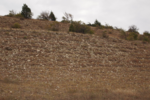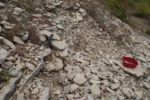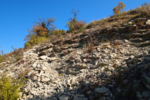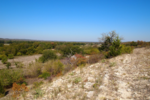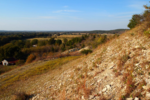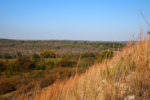
The Hunton group within the Arbuckle Mountain region consists of the following units of strata in surface and subsurface stratigraphy
Frisco formation
Bois D’Arc formation
Lower Devonian Fittstown member
Cravatt member
Haragan formation
Henryhouse formation
Chimneyhill subgroup
Upper Ordovician to Clarita formation
Upper Silurian Cochrane formation
Keel formation
Ideal Quarry member
Modified from Amsden (1967)
Amsden (1960) considered the Haragan, Cravatt, and Fittstown strata to be synchronous deposits. Each has a slightly different biofacies preserved within the fossil assemblages. The Old Hunton town site is the type locality for the Hunton group (Amsden, 1957), where the total Hunton thickness is estimated at over 400 feet.
In descending order, exposures of the Frisco formation, the Bois D’Arc formation, with Fittstown and Cravatt members, the Haragan formation (228 feet), and the Chimneyhill subgroup (represented by the Clarita, Cochran, and Keel formations) are recognized in this area. The type section for the Clarita formation is also nearby the Old Hunton town site (Amsden, 1960).
Amsden produced a detailed stratigraphic section of the Hunton group outcroppings within this area (Amsden, 1960). Over 200 feet of the Devonian formations are exposed, while an extensive thickness of the Silurian Chimneyhill subgroup is also present. Only the Henryhouse formation is absent, or covered in this area, he remarked. However in 2020 I realized that a loose piece of Hunton rock recovered from a dig out below the outcrop that was used as fill for the adjacent reservoir is Henryhouse strata. The rock has a Scyphocrinites crinoid cup within it and two brachiopods, both of which are typical Henryhouse formation brachiopods. Originally I had interpreted it to be Devonian as Scyphocrinites has been found at the Old Hunton town site years ago by Allen Graffham's wife in a plate. There are two species recorded, one from the Henryhouse formation within the Silurian and the other one from the Devonian Haragan formation from the plate found in the 50s I believe by Mrs. Graffham. While this crinoid is never found on the outcrop large stems are present within the Haragan formation and I've assumed that they were Scyphocrinites and that the crinoid occurs here. I have two cups now from pieces of strata recovered within the digout area below the outcrop. No beds are apparent there. Neither piece has trilobite fragments that I know of. Regardless, the Henryhouse brachiopods within the one piece lend credence that the Henryhouse formation is present there but is covered and that the Scyphocrinites occurrence is Silurian as well in this instance.
The Haragan and Bois D’Arc faunas are very similar, containing many of the same species, and yet there are notable differences exhibited within those faunas that are distinguishable. Their lithologies are also characteristic, in spite of the similar appearance of the rock layers. The composition of the marlstone or calcilutite appears to be distinctly different between the two formations. While Haragan rocks are similar in color and grain size to those of the Bois D’Arc, the Haragan rocks are softer in texture, while the Bois D’Arc rocks have a firmer, grainier appearance. Generally, the Haragan marlstone layers are thicker than most layers within the Cravatt member. Thin layers of Haragan strata are similar to Cravatt member rocks, yet many of the fossils appear to be partially silicified within the Cravatt member. The Cravatt member rocks are also lighter in color, as a buff shade of white, while Haragan rocks exhibit a more yellowish cast. Both have light shades of tan, brown, yellow, and cream in their appearance.
There are several zones within the outcrop that are productive trilobite horizons. Some of these layers have been quarried in adjacent exposures of these formations nearby. While not conclusive, they do indicate that different exposures can be correlated by these markers. Biozones are recognized by the composition of these assemblages. Certain trilobites are restricted in their occurrence, while others appear to be found in both formations. The same is true of many of the brachiopods, as they also exhibit certain restrictions noted in their distribution. While some genera of trilobites are represented by individual species within each formation, others have not been. Notably, Cyphaspis carrolli, Cordania falcata, Cordania wessmani, Ceratonurus sp., Viaphacops sp., Reedops deckeri, Paciphacops campbelli, Paciphacops birdsongensis, Kainops invius, and Kainops raymondi are restricted in their occurrence. However, species of Huntonia, Kettneraspis, Dicranurus, Echinolichas, and Breviscutellum appear to occur in both formations, for the most part, as they have not been further differentiated. Other rare species that are seldom found also have restricted ranges, but that could easily be the result of an incomplete record due to their obscurity.
The presence of complete specimens of some of these trilobites in assemblage zones has been known for some time. The same is true of the distribution of some of the larger brachiopods found within the Cravatt member. Other fauna of notable distinction (crinoids, cystoids, starfish, fish remains, etc.) that are found here may be restricted also, but their presence is too infrequent to ensure an accurate determination as to where they can be presumed absent.
New discoveries concerning the fauna of the Haragan and Bois D'Arc formations slowly evidence themselves during many long hours on the outcrop. Even though these insights are slow to be uncovered, they continue to inspire ones' desire to learn more about this interesting period of earth's history. Discoveries of pieces of Huntonia trilobites representing individuals up to one foot in length, or lichid fragments indicating lengths of 8 to 10 inches belie what is normally found here. Perhaps little is actually known about many of the invertebrates that are taken for granted here, because invariably, nature has not allowed every aspect of the existence of these creatures to be easily discerned. Only through the patient methodical process of observation do these previously unknown characteristics of the faunas become known. With trilobites, complete specimens are always welcome, but sometimes the incomplete fragments are just as enlightening, and often are overlooked. And even while brachiopods abound here and have been studied relentlessly, there are still species here that may have not been recorded. The same is basically true for echinoderm species, which continue to be revealed. A few crinoids that I have found pieces of are undescribed from here but occur elsewhere in North America.
At one time, when I first began collecting fossils here, armored worms were essentially still unknown, and were only known from fragments at other localities. Yet they were often found here during a days' collecting. Cystoids had not been reported, and the relationships between the Haragan trilobite faunas and Bois D'Arc trilobite faunas were hardly understood. The collections of fossils that had been amassed over the years mostly left scientists with a lot of loose ends to speculate upon. From the advent of the 1980s on, there have been many skilled professionals who have helped to make this area known to the world now. These efforts have greatly enhanced our knowledge of the faunas within these formations. We hope to continue in that effort by reporting new observations uncovered during our continuing investigations.
